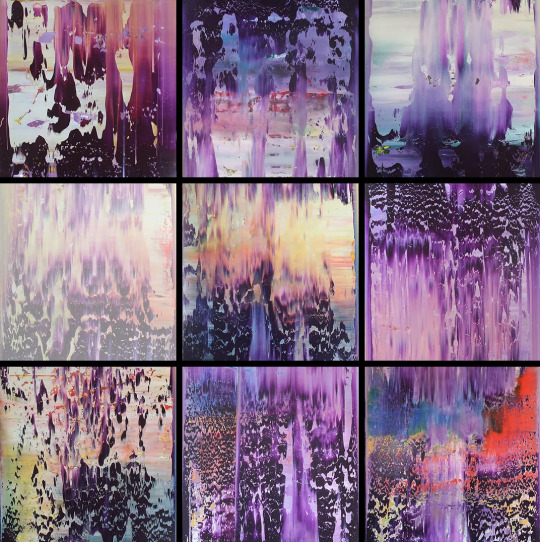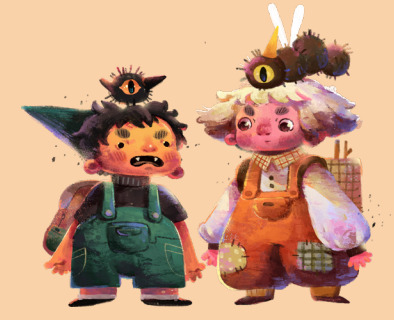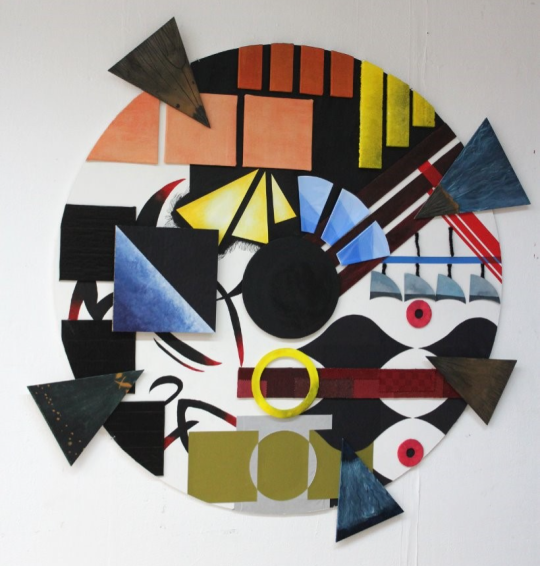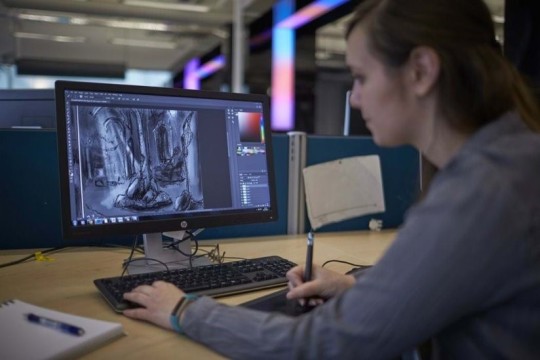Freya Campbell is currently a Contemporary Art student studying in Aberdeen that aims to tell stories through paintings. Her work is greatly inspired by the day to day life around us as well as a deep enjoyment of film and tv and how they show stories using a visual format.
Don't wanna be here? Send us removal request.
Text
Membership & Organisations
One of the wonderful things about following art as a career is the community of creatives that you can constantly learn from. This learning can be technical such as sharing how to improve the blending of oil pastels with a contemporary, but can also be conceptual where artists have opportunities to be exposed to new ideas and concepts that can inspire their future work. When starting out on a creative career this learning environment is found more easily (like in an art class or attending a creative-industry based university or college) but once out of further or higher education artists can miss the social element which can be more challenging. This is one of the reasons that many artists join art organisations and professional bodies - to benefit from the supportive community environment to encourage, inspire and lend a helping hand.
When it comes to professional bodies the Scottish Artist Union is the main organisation in Scotland. There are numerous reasons for joining the union including: legal advice from professionals, discounts for materials at more than one art shop across Scotland, resources from a network of artists to give and receive advice/support/guidance and insurance (all of which are free to those who belong to the artist union). However you are required to pay a membership fee which is £72 every year (commencing April each year) to gain access to these benefits. Alternatively they offer a graduate membership program for those finishing their educational and who are ready to move into the profession. If eligible, this option is only three pounds every month (total of £36) to allow graduates to get on their feet.
When researching different organisations and membership options, Visual Arts Scotland was the top hit on the search list and has been supporting artists, designers, craft makers and practitioners since the 1980s. Their website advertises three different types of membership to better accommodate different people and what they want out of the organisation. The cheapest they offer is the Associate Membership which is only £28 for a year of access to the many benefits Visual Arts Scotland provide. For example: the online portfolio, reduced submission fees, discounts from related providers, and being promoted on their Facebook or twitter page. The associate membership plan is aimed at young people and students, but they also offer their Ordinary Membership (£28 annually) along with the most expensive Professional Membership that is £54 every year.
The next organization I researched is the Scottish Contemporary Art Network (SCAN) that is dedicated to more modern creative pursuits. The members of SCAN are supported with many benefits such as: information in the form of talks, exhibitions and meetings but also being part of a wider network of artists to share ideas, events or job opportunities with (you would also be able to promote your own personal projects through their online presence and social media platforms). The Scottish Contemporary Art Network offers a total of 7 different options when regarding memberships for both individuals but also many for public bodies/organised groups which I haven't seen on other websites and membership programs. When it comes to individual application the fee is between £24 and £48 depending on lifestyle and financial wellbeing.
Lastly is the Glasgow Society of Women Artists which is a more restrictive organisation both because it only applies to women but also because it is aimed at the Fine Arts like painting, sculpture and ceramics. Due to the high standard that this group upholds they only except one artist every year and the lucky lady must be very skilled and dedicated to access the benefits provided (exhibition opportunities and society events like an annual dinner, a springtime trip and attendance to their monthly relaxed meetings where they have discussions as well as learning opportunities).
As you can see there are memberships aimed at many different types of artists that tailor to the interests and lifestyle of the applicant. These three I have discussed are all for contemporary and fine arts in Scotland but there are also more international ones that connect people from all over the world, as well as even more niche groups dedicated to only oil painting or a specific town or city.
700 words
---------------------------
Sources:
https://www.gswa.org.uk/
0 notes
Text
Funding & Exhibition Opportunities
There is a common misconception that being a full-time professional artist is an unattainable goal, whether due to financial instability or getting the work that you have done out there in to the public eye. In this written piece I will show my findings on different options that artists have when it comes to researching for project funding and how practitioners can support themselves with these available opportunities.
The first bursary fund that I found is the ‘Open Fund for Individuals’ that is facilitated by Creative Scotland. It offers £500 – £100,000 for a creative mission or project that the artist works on with a start and end date lasting no more than 24 months. This is a wonderful opportunity for creatives as it is very broad when it comes to what people can work on, as well as being a generous amount of money offered (especially when compared to others that I have researched). The money in question is funded by the National Lottery which gives Creative Scotland an annual budget of 5 million pounds. The Open Fund can be used to fund research or the development stages of a project, as well as the distribution or delivery of a creative pursuit. In the past this has been used by writers, producers and artists that have applied through the online portal. Creative Scotland has a FAQ's section and downloadable documents to help hopefuls through the application process and provides support contact details for those who may struggle with the steps involved. The fund does not have a deadline (is open year round) but there is a list of requirements that must be met - the applicant must be over 18, be self-employed or a freelance creative Living in Scotland with a project plan and who has a UK bank account in their name.
The second funding opportunity that I have found is a local one that is specific to Aberdeen City residents known as the ‘VACMA’ for Aberdeen. (Visual Artist and Craft Makers Award). If an application is successful, £750 can be offered to an artist with experience exceeding five years, a further £500 for an 'Early career' bursary is offered. Both are aimed at furthering the applicant's education by paying for a course, workshop or time to study and research a new piece of work. Alternatively, the fund can support artists to help buy artistic materials or get access to processes (like a kiln etc). As the name suggests, to be considered for this bursary you must live or work in the City of Aberdeen but there are a few other limitations as well. Applicants cannot be in full time education or use the money to self-promote by means of websites, promotional content or directly business-related things. Other cities across Scotland have their own versions of the fund, so residents in other Scottish cities can also apply.
Unlike the last two which are very broad when it comes to what the projects are required to be, the last bursary that I researched is very specific to a particular creative path. This fund is offered by Screen Scotland and is under the title of 'Film Development and Production Fund' which is an amount between £3,000 and £50,000 that can be used to go towards the production or development of a screen-based art project. But despite being more narrow an option it covers a large range of things within that, whether it is the employment of cast and crew, a budget for a feature film/documentary/animated film or even to purchase the rights to an idea that already exists but the applicant then has the right to change and adapt it into the finished piece they are aiming for. Similar to the ‘Open Fund for Individuals’, the Screen Scotland funding does not have a deadline date so can be applied to at any time through the British Film Industry’s online portal. Before being accepted, the applicant must read through a set of documents to educate them on the logistics of the funding as they must enter the contract knowing the guidelines in full. This is a really great opportunity that aims to help gain recognition for Scottish filmmakers whether they are writers, directors, model makers or camera and editing crew. Screen Scotland want to promote Scotland's creativity, culture and diversity to an international level. This organisation also offers many more opportunities for Scotland based digital artists through their website and works in a close relationship with the British Film Institute.
So, now you have funding but how do you get people to see your art? Well there are many opportunities to exhibit your work if you know where to look. For a local example, Aberdeen Art Fair has displayed work for the last 12 years at the Aberdeen Music Hall. In preparation for the late August to early September exhibit those from galleries, print studios, artists and collectives of artists can apply with 6 pieces that show what they would like to display (or similar to what they would like to display). Applicants find out more specifics through the email that is left on their website and must also give the £595 price for the stand/space. This is a wonderful opportunity for contemporary artists who wish to get their work out into the world, be able to use as a past experience while working towards a bigger goal but also sell both originals and prints to those who come to the show.
As you can see there are many opportunities out there for creative people in Scotland if you know where to look to find them as well as researching and being aware of what they are, when the deadlines hit and which ones you are eligible for.
956 words
---------------------------------
Sources:
0 notes
Text
Freya Campbell - Artist Statement
As an artist I want to talk to people, not face to face but show them something they can see to believe. I think this is one of the main reasons I'm drawn to storytelling as it has always been used as a way to educate people whether as myths about ‘Kelpies’ to teach kids about drowning or a literal depiction of a real event to raise awareness and allow people to understand. The other side of storytelling is often taken for granted or devalued and this is the entertainment side of art, we are one of few species that amuse ourselves this way. The joy and fun fueled by art and stories can be just as valuable to society and culture as activism and the sharing of knowledge.
I strive to do just that by creating work that will help people, and help can be in many different ways: a sad one people can relate to and not feel alone, one to show happiness and optimism, showing an issue in an emotional way to encourage action compared to devastating statistics but also the sometimes needed joyful escapism found through any form of art. Of two disciplines I currently enjoy, the first is using painting and drawing inspired by photorealists like Ralph Goings whilst at the same time using symbolism and artistic theory to display a meaning. The second discipline is film making, more specifically the ‘Mise-en-scèce’ a term referring to the things we see on screen and how they aid the storytelling through a visual way (the state of a character's room that gives insight into them as a person or their mental state).
1 note
·
View note
Text
Careers In Art
Art is unfortunately renowned as a difficult industry to get into and even if you do there is no expectation of success or financial stability. This is partially because there is no set path to become an artist and there is no absolute requirement for a degree or mandatory years of practice/study. Many of the best artists didn't go through further education at all but still find success based on learnt skills and passion. To demonstrate I will describe the career path of a designer, a commission-based artist and abstract painter.
Firstly, I will give the example of Harry Moody and how he built his successful career. Moody is an established contemporary artist who specialises in abstract expressionism painting. He originally studied at an art school in Frankfurt called Staidel Academy where he studied "Free Painting". Here he was influenced by many accomplished artists, and Moody learnt from another painter Johannes Schreiter to give advice and inspiration. He also learnt from Gerhard Richter (another successful contemporary artist) who widened Moody’s knowledge of philosophy and helped him build a more holistic view of art.

Image: harrymoody.com ('Purple Dozen')
contrast, Lulu Chen has had a very different experience when it comes to her artistic career. She began with an Associate of Arts degree in illustration from the Academy of Art University based in San Francisco (2016-2018). Following this she studied at Sheridan College in 2019 and was awarded a Bachelor's of Animation in 2023. Chen however, also strove to gain experience and knowledge outside of educational establishments, serving an internship at Sony Pictures and freelancing on a project at Pipeline Studios.

Image: salustudio.com (Lulu Chen)
Stanley Donwood is most famously known for his art used on the covers of Radiohead's albums in the 1990s, for which he was awarded more than one GRAMY. Education wise he firstly studied at North Essex College of Art in 1987 where he spent a year completing a foundation art course before moving to study Fine Arts degree at Exeter College of Art (1988-1991).
Many artists have studied the fundamentals of art, and the first course example that I researched is offered by the University of Dundee who offer a BA(Hons) or BDes(Hons) in Art and Design. Students do one year as a foundation before either moving on to a specialized course (they offer a large range from medical/forensic art to courses that cover game and film) or completing the four-year degree. To gain access to this course an HNC (Grade B) is required, but candidates also need to submit a portfolio as a sample of their work so they can gauge both the grades and skill before accepting a potential student. Once graduated alumni can pursue many careers for example roles in the art department for the creative industries or set up yourself as a practicing artist.

Image: dundee.ac.uk (Art & Design)
Next is the Fine Arts BA(Hons) also from Dundee, which is a three-year course that has a focus on juggling creation and critical thinking to make art of different types. The entry requirements for this fine arts course are an HND at B grade but you also qualify if you have completed an art foundation course. As with the art and design course, students can have the opportunity to study abroad during their degree. This course is taught by practicing artists, and the students have access to a wide variety of studios and workshops spanning the whole creative department. As this is a fine arts course it is more aimed at those who wish to be creating and exhibiting art, but it does have a wide range of future uses as it still teaches the principles of any art course and the experience would be useful for other things instead of the artists wanting to show in galleries.
Lastly, I looked into the Computer Arts BA(Hons) offered at Abertay University in Dundee which is a very popular course due to being the only one like it for a far reach. This course is more about the design side compared to the fine and traditional arts previously mentioned. The student will study for four years to develop skills in digital arts, design, animation, concept art, visual arts and illustration as well as a knowledge of practitioners, contextual analysis and critical thinking. The entry requirements are a B from HNC in a related subject (Art & Design or CAP etc) and if accepted will have access to many studios equipped with wonderful facilities. As a course it is very aimed at entering the industries and has links to Unreal engines, Screen Skills and has a DARE program. With this degree graduates are likely to work in the art and design department for the gaming, animation, film or illustration industries.

Image: abertay.ac.uk (computer arts)
All this considered, it's clear to see that path to becoming an artist can be taken in many different ways despite the wide variety of backgrounds and pathways that lead them to the end goal whatever that may be.
(820words)
——————————————————————————
Freya Campbell – May 2024
Sources:
1 note
·
View note
Text
A time-lapsed recording of a piece inspired by the creative center's of Aberdeen, more specifically the wonderful HMT.
——————————————————————————
Freya Campbell – of 2024
Materials: Acrylic paints (with use of a blending medium), Photos printed onto cartridge paper then collaged with PVA glue, a lot of tea for motivation.
On a canvas prepared with Gesso
1 note
·
View note
Text









This set of nine studies depicts the experience of growing up (one with everyone undergoes) through a series of object. For these I used a mix of medias – and where possible – tried to match the materials to the time or object that’s being represented: for example the first of the nine “Building Blocks” is colourful pens which is a classic of any toddlers pencil case.
From plush childhood friends to warn and torn hobby paraphernalia everyone holds sentimentality within objects and from these there is much to interpret about that person and their lives. I used items from my childhood which both have relevance to me but also can be relatable to viewers to prompt their own memories.
------------------------------------------------------------------------------
Freya Campbell – March of 2023
Materials in order: felt tip and alcohol pens, India ink with water and a brush, gouache paint, graphite pencil, watercolour pencils, biro pen then acrylic paints for the final three
2 notes
·
View notes